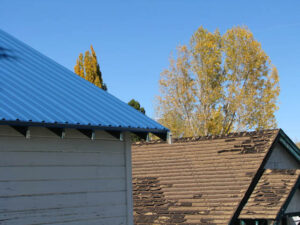

This past month roofers finished installing a new roof on the Mono Basin Field Station. The old roof was well past its prime, decaying and losing shingles with each puff of wind. The new roof is metal and will withstand all the wind and snow the Mono Basin can deliver.
The new roof is the latest physical improvement to this local research station that has been continually hosting research projects since 2004. In 2009 the Field Station hosted Sage Grouse monitoring conducted by California Fish and Game and University of Idaho, and a number of projects with PRBO Conservation Science, including Willow Flycatcher monitoring on Rush Creek. The University of Montana continued with another year of White-crowned Sparrow work, and a student from California Polytechnic State University gathered data on arsenic concentrations in brine shrimp and alkali flies at Mono Lake.
Even field researchers can use a roof over their heads. Accommodations and a place to input data are limited commodities in the Mono Basin. Science and research makes for informed decision-making and the Mono Lake Committee is doing what it can to further scientific work in the Eastern Sierra.
